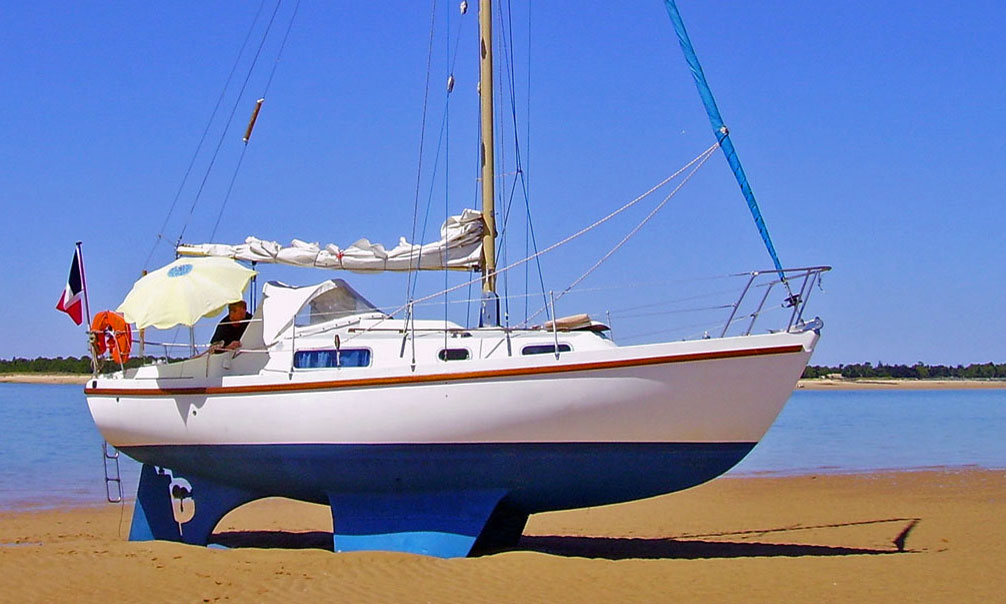Understanding Sailboat Keels: Types, Design & Performance Characteristics
In a Nutshell: What Sailboat Keels are All About
A sailboat's keel isn't an optional extra; it's a foundational part of its design. The type of keel a boat has fundamentally shapes its sailing characteristics, from how fast it can sail to windward to where it can safely anchor. Understanding the various keel types, their design, and their trade-offs is key to appreciating a boat’s capabilities and limitations.
 A Lifting-Keel Ovni 395 waiting to re-float on the next incoming tide.
A Lifting-Keel Ovni 395 waiting to re-float on the next incoming tide.Table of Contents
- What are the Primary Functions of a Sailboat Keel?
- What are the Different Types of Sailboat Keels & Their Trade-offs?
- The Material Difference: Lead versus Cast Iron
- How do Keel Hydrodynamics Affect Performance?
- Keel Design & Hydrostatic Stability
- Understanding the Center of Lateral Resistance (CLR)
- Keel Maintenance, Repair & Safety
- Final Thoughts
- Frequently Asked Questions
What are the Primary Functions of a Sailboat Keel?
A sailboat keel performs two essential functions. Firstly, it provides ballast, a heavy weight positioned low down to counteract the sideways force of the wind on the sails, preventing the boat from heeling excessively and capsizing. Secondly, it provides lateral resistance, acting like an underwater wing to prevent the boat from slipping sideways (leeway) as it sails to windward. The more effective the keel is at these tasks, the better the boat's stability and upwind performance.
What are the Different Types of Sailboat Keels & Their Trade-offs?
The world of sailboat keels offers a variety of designs, each with a specific purpose and a set of trade-offs. As an experienced sailor who's spent a lifetime in boats, I’ve had personal experience with many of these designs, and their real-world pros and cons are often very different from the theory.
...........
Long & Full Sailboat Keels
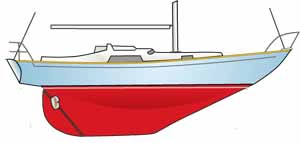 Long Keel: Robust construction and a comfortable motion but inherently slow
Long Keel: Robust construction and a comfortable motion but inherently slowThese are the robust, slow-and-steady keels found on traditional heavy-displacement cruisers. They're often a structural part of the boat's hull construction, with encapsulated ballast, making them extremely strong. A classic example is the Nicholson 32.
Pros:
- Comfortable Motion: They track through the water as if on rails, providing a comfortable and predictable motion in a seaway.
- Durability: The encapsulated ballast and integral construction make them incredibly robust and resistant to damage from minor groundings.
- Propeller Protection: The propeller is often housed in an aperture, protecting it from floating lines and debris.
- Ease of Handling: They heave-to readily, which can be a valuable asset for offshore sailors needing to pause for a meal or a repair.
Cons:
- Lack of Manoeuvrability: They're notoriously difficult to manoeuvre in tight spaces, such as marina berths, and require plenty of space to turn.
- Reduced Speed: The high wetted surface area creates significant drag, making them slow, especially in light winds.
...........
Encapsulated Fin Keels
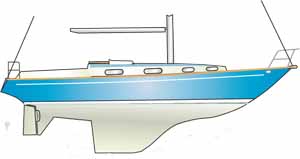 Encapsulated Fin Keel: Most of the benefits of a long keel, but faster under sail and more maneuverable under power
Encapsulated Fin Keel: Most of the benefits of a long keel, but faster under sail and more maneuverable under powerA step up from the long keel, this design separates the keel from the rudder, greatly improving manoeuvrability. The Contessa 32 is a highly regarded example of these long-fin and skeg-hung rudder sailboats. The encapsulated design retains the safety benefits of a robust, bolt-free construction.
Pros:
- Improved Manoeuvrability: The separated rudder allows for much sharper turns and better handling under power.
- Hybrid Performance: It offers a better balance of upwind performance and directional stability compared to a full keel.
- Robustness: With no keel bolts to worry about, this design maintains a strong connection to the hull.
Cons:
- Reduced Upwind Performance: Still not as efficient as a deep fin keel.
...........
Deep Fin Keels
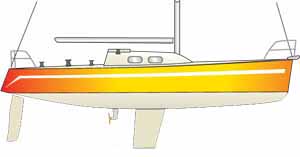 Deep Fin Keel: The racers choice, highly efficient and fast, but have been known to drop off because of poorly engineered fixings or corroded keel bolts
Deep Fin Keel: The racers choice, highly efficient and fast, but have been known to drop off because of poorly engineered fixings or corroded keel boltsThe quintessential racing keel, this design is manufactured separately and bolted to the hull. Its high aspect ratio provides maximum lift and minimum drag, allowing the boat to point closer to the wind and reduce leeway.
Pros:
- Superior Performance: Highly efficient and fast, particularly when sailing to windward.
- Hydrodynamic Lift: The keel acts like a foil, creating lift that reduces leeway and pulls the boat to windward.
- Lightweight Construction: The design allows for a lighter boat overall while maintaining stability.
Cons:
- Vulnerability: Keel bolts are susceptible to corrosion and must be regularly inspected. Poorly engineered fixings can lead to catastrophic failure.
- Limited Access: The deep draft restricts access to many shallow anchorages and cruising grounds.
- Risk of Grounding: When you're sailing in an unfamiliar area, a deep keel can run you aground, and the boat can be difficult to unstick.
...........
Retractable & Lifting Keels
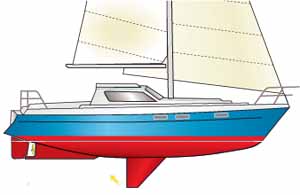 Retractable Keel: Deep/shoal draught compromise that enables upright drying out, but subject to jams and mechanical failure
Retractable Keel: Deep/shoal draught compromise that enables upright drying out, but subject to jams and mechanical failureA popular choice for shallow water cruising, these keels can be raised or lowered via a manual or hydraulic system. Some, like the Ovni 395 (see pic at top of page), have a ballast stub keel, while others retract completely into the hull. This allows for both deep water performance and shoal draft convenience.
Pros:
- Versatility: Provides a deep keel for offshore sailing and a shallow draft for exploring skinny waters.
- Upright Drying Out: Many designs, especially those with twin rudders, can dry out on a hard or mud flat, which is great for maintenance and low-cost moorings.
Cons:
- Mechanical Complexity: The system of ropes, pulleys, or hydraulics adds complexity and potential for failure. Having experienced a few jams myself, I can attest to the worry this can cause.
- Noise: The centreplate can rattle in its housing, particularly in a rolly anchorage.
- Internal Space: The keel housing often encroaches on the boat's internal accommodation.
...........
Twin & Bilge Keels
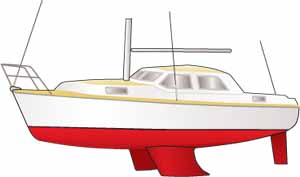 Bilge (or Twin) Keels: Takes advantage of cheaper dryng moorings at the cost of performance under sail
Bilge (or Twin) Keels: Takes advantage of cheaper dryng moorings at the cost of performance under sailThese are particularly popular in the UK and are perfect for tidal cruising grounds. They consist of two separate keels mounted off the centreline, allowing the boat to rest upright on a drying mooring.
Pros:
- Drying Moorings: The primary benefit is the ability to use inexpensive drying moorings, which are plentiful in tidal areas.
- Safety: A grounding isn't as much of a concern as the boat is designed to sit on the bottom.
- Directional Stability: The twin keels can increase directional stability, though at the expense of speed.
Cons:
- Slower Performance: The increased wetted area creates drag, reducing sailing performance, particularly in light airs.
- Aground, you're Aground: Once a twin-keeler runs aground, it’s often difficult to get it off again until the tide returns, as you can't heel the boat to reduce its draft.
...........
Sailboat Keels with Bulbs or Wings
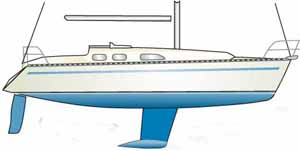 Bulb and Wing Keels: Low centre of gravity, good stability and reduced draught
Bulb and Wing Keels: Low centre of gravity, good stability and reduced draughtModern keel design often incorporates a bulb or wing at the bottom of the keel fin. The purpose of these is to place the ballast as low as possible, reducing the keel’s overall depth without compromising stability.
Pros:
- Reduced Draft: They provide the stability benefits of a deep keel with a shallower draft.
- Increased Stability: By lowering the center of gravity, they increase the boat's righting moment, allowing it to carry more sail area.
- Damping Motion: Wing keels, in particular, can help dampen a boat's rolling motion in a rolly anchorage.
Cons:
- Vulnerability to Fouling: Wings and bulbs, especially those that project forward, are prone to snagging fishing lines, discarded nets, or other debris.
- Maintenance: Anti-fouling the underside of a wing keel requires slings or a diver.
...........
Tandem Keels
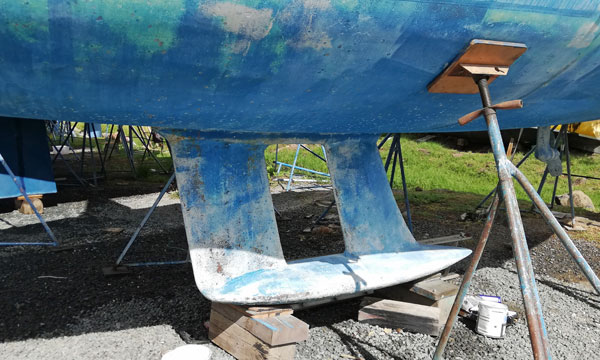 A Tandem Keel—this one is fitted to a Bavaria cruising boat.
A Tandem Keel—this one is fitted to a Bavaria cruising boat.The tandem keel, popularized by designer Warwick Collins, is a unique design that uses two in-line foils connected by a single endplate or bulb. This configuration aims to provide the upwind performance of a deep fin keel while maintaining a relatively shallow draft. It's a niche design that has been featured on some cruising yachts, including models by Bavaria and Etap.
Pros:
- Exceptional Upwind Performance: By maximizing lift and reducing wetted surface area, the tandem keel allows the boat to point high into the wind with minimal leeway, rivaling the performance of a deep keel.
- Reduced Draft: The design allows for a shallower draft than a conventional fin keel, providing greater access to shoal water cruising grounds and anchorages.
- Improved Stability: The endplate or bulb on the tandem keel's bottom lowers the center of gravity and helps dampen the boat's motion, improving crew comfort in a seaway.
- Directional Stability: The long, shallow design improves directional stability, making the boat track well through the water.
Cons:
- Cost & Complexity: The tandem keel is more complex and expensive to manufacture than a traditional single-keel design.
- Maintenance: Like winged keels, the tandem keel's unique shape can make it a challenge to anti-foul the underside and between the foils.
- Vulnerability to Fouling: The two foils and endplate can be prone to snagging fishing gear or debris.
- Repair: In the event of a hard grounding, repairing the twin foils and their connection to the hull can be more complex and costly than repairing a single keel.
The Material Difference: Lead versus Cast Iron
The material a sailboat's ballast keel is made from is a crucial factor that affects both performance and safety.
| Material | Advantages | Disadvantages |
|---|---|---|
| Lead |
|
|
| Cast Iron |
|
|
How do Keel Hydrodynamics Affect Performance?
A keel isn't just a weight; it's a finely tuned hydrodynamic foil. As the boat moves through the water, the keel creates lift, much like an aeroplane wing in the air. This lift is what counteracts leeway and propels the boat to windward.
- Aspect Ratio: A keel's aspect ratio is its length (depth) divided by its chord (width). High-aspect-ratio keels (deep and narrow) generate more lift and are more efficient, but they're also more susceptible to groundings and require more precise engineering.
- Lift & Drag: Keels are designed to maximise lift and minimise drag. Modern keels with bulbs are designed to put the weight as low as possible, reducing the keel's size and therefore its wetted area. While this is more efficient, some modern designs push the boundaries of materials science, as the forces on the keel-to-hull joint are immense.
- Turbulence: The keel's interaction with the hull and the water's surface can create turbulence and drag. Naval architects continuously refine designs to minimise this, leading to innovations like the tandem keel.
Keel Design & Hydrostatic Stability
The keel's primary purpose is to provide stability and resist heeling, a concept known as righting moment. Think of it as a lever. The further the weight (ballast) is from the pivot point (the boat’s center of buoyancy), the more leverage it has to right the boat.
- Righting Moment: A deep keel with a bulb or wing places the ballast far from the pivot, generating a powerful righting moment. This allows the boat to carry a large sail plan and maintain speed in strong winds without heeling excessively.
- Angle of Vanishing Stability (AVS): The AVS is the angle of heel at which a boat loses its righting moment and will no longer return to an upright position. A higher AVS indicates a safer boat in extreme conditions, as it can be knocked down and still recover. A deep, heavy keel generally results in a higher AVS, an important factor for serious offshore sailors.
Understanding the Center of Lateral Resistance (CLR)
To truly understand how a keel performs, you need to understand the Center of Lateral Resistance (CLR) and its relationship with the Center of Effort (CE) of the sails.
The CE is the central point of all the wind pressure on the sails. The CLR is the central point of the underwater foils, including the keel and rudder, that resist sideways motion. For a sailboat to track straight and have a balanced helm, the CE of the sails must be slightly ahead of the CLR of the underwater body.
If the CE is too far forward of the CLR, the boat will have lee helm and tend to turn away from the wind. If the CE is too far aft, the boat will have weather helm and tend to turn into the wind. Both of these conditions require constant pressure on the rudder and can slow the boat down. A good boat has a slight weather helm, giving the sailor a constant "feel" for the boat's performance. The keel's design is the primary factor in determining the CLR.
Keel Maintenance, Repair & Safety
For any boat owner, a keel isn't just a performance feature, but a significant safety factor. Given the forces at play, especially with bolted-on keels, proper maintenance and a plan for potential repairs are crucial.
- Keel Bolt Inspection: On boats with bolted-on keels, keel bolts are the single most important safety component. They should be inspected regularly for any signs of corrosion, which can often be indicated by rust streaking or discoloration around the bolts. A professional surveyor can use techniques like thermal imaging or ultrasound to check for hidden issues.
- The Keel Drop: For a complete and thorough inspection of the keel-to-hull joint and the bolts, a keel drop is sometimes necessary. This is a major job that involves unbolting the keel from the hull. It's a vital procedure for older boats or those that have experienced a hard grounding.
- Repairing Damage: While encapsulated keels are generally more robust, all keels can be damaged by a hard grounding. Lead keels, being soft, will often deform on impact, absorbing energy and protecting the hull. Cast iron keels are stronger but more brittle and may transfer impact energy to the hull, potentially causing cracking. Professional repair often involves grinding away damaged material, re-fairing the keel, and re-encapsulating or re-bolting it.
Final Thoughts
Understanding a boat's keel is a great way to understand its capabilities. The different designs are a reflection of the various priorities that sailors and naval architects have in balancing performance, practicality, and safety. Each keel type represents a unique compromise, and appreciating these distinctions is a core part of a sailor's knowledge.
When you're considering the performance and safety characteristics of any sailboat, the keel is just one part of a larger, interconnected system. To truly appreciate how a boat's design influences its behaviour, it's essential to look at the broader picture of its structural integrity, stability ratios, and regulatory compliance. This article is part of a series on sailboat design. To learn more about how a keel fits into the bigger picture of a boat's performance and safety, read our comprehensive article, "Mastering Sailboat Design Ratios & Regulation for Performance & Safety".
This article was written by Dick McClary, RYA Yachtmaster and author of the RYA publications 'Offshore Sailing' and 'Fishing Afloat', member of The Yachting Journalists Association (YJA), and erstwhile member of the Ocean Cruising Club (OCC).
Frequently Asked Questions
What is a ballast keel?
What is a ballast keel?
A ballast keel is a heavy weight, typically made of lead or cast iron, positioned at the bottom of the boat to provide stability and counteract the force of the wind on the sails.
Can a sailboat keel break off?
Can a sailboat keel break off?
Yes, in rare cases, a bolted-on keel can break off due to degraded keel bolts, poor construction, or a severe impact. This is a primary reason why regular maintenance and inspection of keel bolts are crucial.
What is the difference between a fin keel and a full keel?
What is the difference between a fin keel and a full keel?
A fin keel is a deep, narrow appendage bolted to the hull, optimised for speed and upwind performance. A full keel is a long, integrated part of the hull, known for its directional stability and robustness.
Which keel is best for offshore cruising?
Which keel is best for offshore cruising?
Many traditional offshore sailors prefer long or encapsulated keels due to their strength, comfortable motion, and predictable handling in rough seas. However, many modern offshore boats with deep fin keels are also highly successful.
Sources Used
- "Sailboat Keel Types: Pros And Cons 2025" from Two Get Lost: https://twogetlost.com/sailboat-keel-types
- "The physics of sailing" from Physics Today: https://pubs.aip.org/physicstoday/article/61/2/38/413188/The-physics-of-sailingSails-and-keels-like
- "What are the pros and cons of different keels?" from Sirius-Yachts: https://www.sirius-yachts.com/choosing-the-best-keel/
- "Keel construction and design explained" from Rustler Yachts: https://www.rustleryachts.com/keel-design-explained/
- "Winged keel" from Wikipedia: https://en.wikipedia.org/wiki/Winged_keel
- "Pegasus 50 - Tandem keel explained - Owner's insights" from YouTube: https://www.youtube.com/watch?v=a0D9RvIGcUs
Recent Articles
-
Yacht Clearance in the Caribbean: A Sailor's Guide
Nov 25, 25 07:13 AM
Navigating yacht clearance in the Caribbean is essential for a smooth sailing trip. This guide, written by an experienced sailor, explains the required papers, procedures & tips for a hassle-free expe… -
Beneteau Oceanis 36CC: Specs, Ratios & Cruising Suitability
Nov 25, 25 06:08 AM
Detailed analysis of the Beneteau Oceanis 36CC centre cockpit sailboat. Includes design ratios, full specifications, and practical assessment of its suitability for experienced offshore and liveaboard… -
Essential Boat Toilet Maintenance & Systems: A Sailor’s Guide
Nov 24, 25 01:17 PM
Master boat toilet maintenance, from manual sea heads to 12v electric systems. Get an experienced offshore sailor’s guide on avoiding clogs, leaks, & bad smells.
